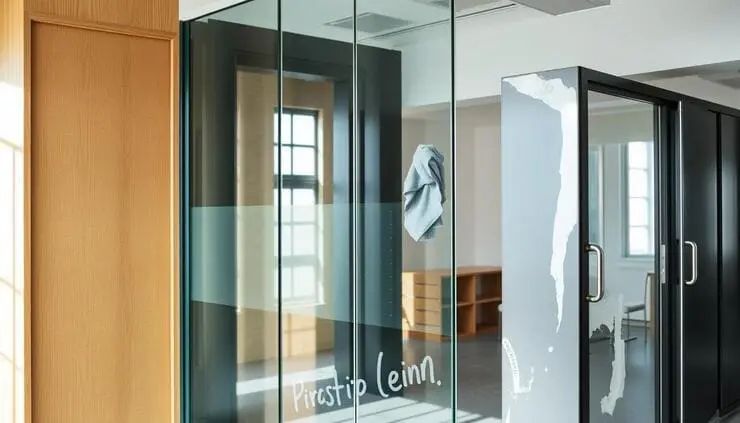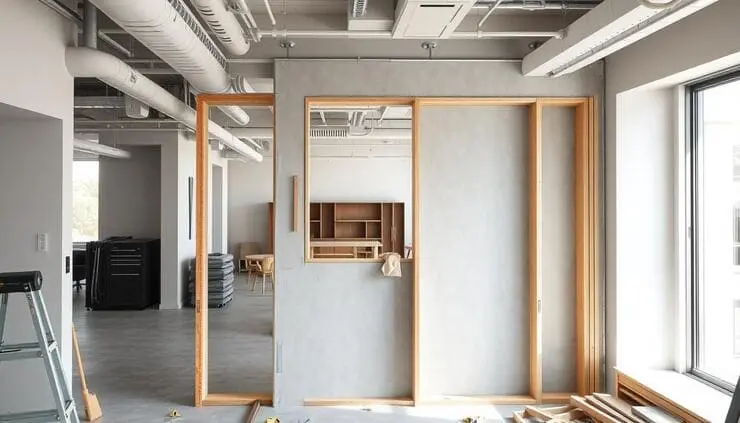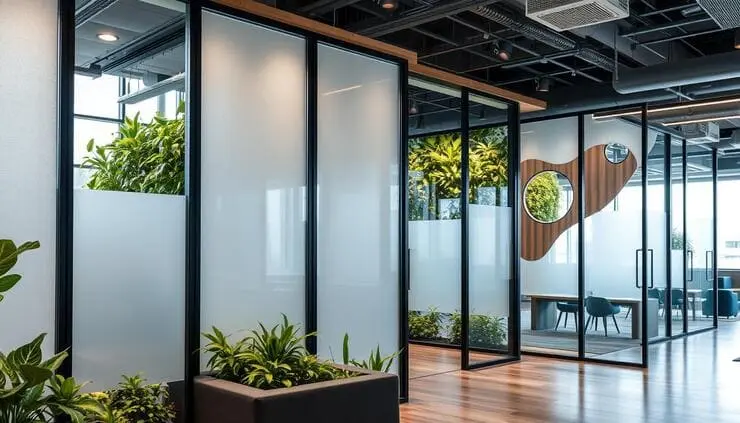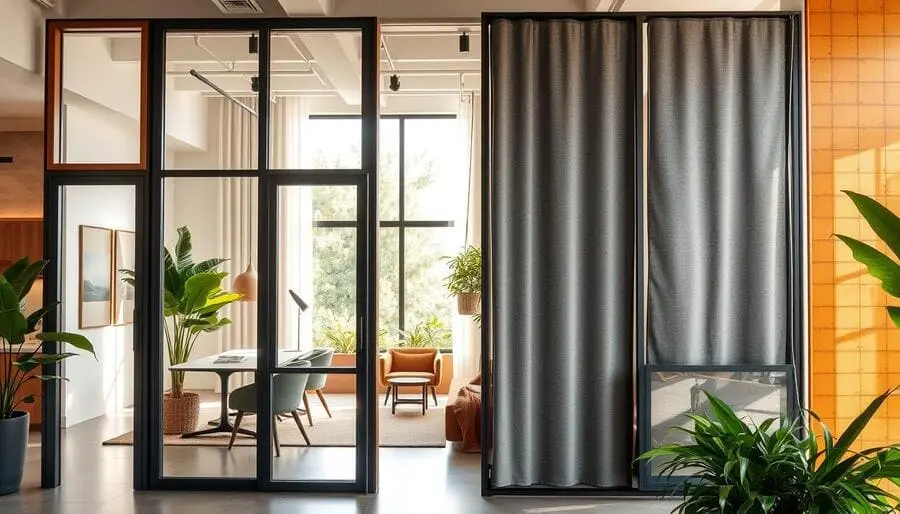Table of Contents
Introduction
Partition walls are one of the simplest yet most transformative features you can introduce into your home. Whether you’re working with an expansive living area or a compact apartment, they have the ability to divide, define, and personalize your space. These versatile structures are more than just a functional solution; they can enhance the flow of your home, offer privacy, and create an entirely new ambiance. In this article, we will explore how partition walls can maximize both space and privacy, as well as the many ways they can be customized to fit your unique needs.
What is it about ? A Quick Overview
Definition and Purpose
At their core, partition walls are non-load-bearing walls that divide a larger space into smaller sections. Unlike traditional walls, which are designed to support the weight of a structure, they serve the sole purpose of creating individual rooms or zones. They can be permanent or temporary, depending on your needs. They help maintain privacy, enhance room functionality, and offer creative design options without the need for expensive renovations.
Key Differences Between Partition Walls and Traditional Walls
Partition walls differ significantly from traditional walls in both structure and purpose. While traditional walls often serve as both boundary and structural support, partition walls do not bear the weight of a building and are typically much lighter in construction. This makes them easier to install and remove, providing greater flexibility. Additionally, they offer the unique benefit of being customizable in ways that traditional walls often cannot, such as the inclusion of built-in storage, glass panels, or movable designs.
Why Partition Walls Are a Game Changer for Your Home

Boosting Privacy in Open Spaces
Open-concept living is a popular design trend, but it can sometimes come at the expense of privacy. Partition walls are an excellent way to introduce personal space without losing the spaciousness of an open layout. They allow for visual separation between living, dining, and working areas while still allowing light and air to flow freely between spaces. In bedrooms or home offices, they can provide the solitude needed for focus and relaxation, transforming a shared room into an intimate retreat.
Creating Functional Zones for Multi-Purpose Rooms
Many modern homes are designed with multi-use spaces, especially in apartments and studios where space is limited. Partition walls help create distinct zones, each tailored to a specific function. For instance, a partition wall can separate a living area from a dining space, or divide a home office from a guest room. By carefully planning the layout, you can ensure that each section is as functional as it is stylish.
Enhancing the Aesthetic Appeal of Any Room
In addition to their functional benefits, partition walls can significantly enhance the aesthetic appeal of a room. A well-chosen partition can serve as a visual focal point, complementing the room’s overall design. From sleek, modern glass partitions to rustic wooden screens, the material and style of your partition wall can tie the room’s theme together. They are available in endless styles, so you can easily match them to your existing décor.
Types of Partition Walls for Every Need
Permanent vs. Temporary
Partition walls can be classified into two broad categories: permanent and temporary. Permanent partition walls are fixed structures that are built into the room. These provide a long-lasting solution and are typically used when you need a more solid division. Temporary partition walls, on the other hand, are often portable and can be adjusted or removed as needed. They are ideal for creating flexible spaces or for renters who are unable to make permanent changes.
Different Materials for Partition Walls: Wood, Glass, and More
The material you choose for your partition wall plays a crucial role in both its functionality and appearance. Wood is a popular choice for its warmth and natural appeal. It can also be easily customized with finishes, paint, or wood stains. Glass partitions, on the other hand, allow light to pass through, maintaining an open feel while still offering privacy. For a more industrial or modern look, metal or concrete partitions can add an edgy touch. The material you select should align with your privacy needs, aesthetic preferences, and budget.
Folding and Sliding Partition Walls for Flexible Spaces
Folding and sliding partition walls offer unparalleled flexibility. These types of walls can be opened or closed depending on your needs, making them perfect for spaces that require versatility. A folding partition is ideal for large areas that need to be subdivided quickly, while sliding walls are great for creating temporary separations without permanently altering the space. Both options can also be used to create a seamless transition between rooms when desired.
How to Choose the Right Partition Wall for Your Room
Factors to Consider: Room Size, Layout, and Style
When selecting a partition wall, consider the size of your room, its layout, and the intended purpose of the partition. A large room may require a sturdier, more permanent wall to divide spaces effectively, while a smaller room might benefit from a lighter, more open partition. The layout of the room also plays a key role; for example, a narrow room may benefit from a folding partition, while a spacious living area could benefit from a floor-to-ceiling wall. The style of the partition should also blend seamlessly with the room’s décor, enhancing rather than detracting from the overall aesthetic.
Matching Partition Walls to Your Home’s Design Theme
Partition walls come in a variety of styles that can complement your existing home design. Whether your home features a minimalist, rustic, or contemporary design, there is a partition wall that fits. Choose a material and design that enhances the room’s vibe. For example, if your home features lots of natural wood accents, a wooden partition wall would be a great choice. Alternatively, for modern spaces, sleek glass or metal partitions can create a chic and airy atmosphere.
DIY Partition Walls: Easy Ideas to Try at Home
Step-by-Step Guide to Building a Simple Partition Wall
If you’re looking to build your own partition wall, it’s easier than you might think. Start by measuring the area where you want the partition to go. Gather materials such as plywood, screws, a hammer, and a level to ensure everything is straight. Construct a basic frame, then attach your material of choice (wood, drywall, etc.) to the frame. For a more permanent structure, ensure the wall is securely fastened to the floor and ceiling.
Creative DIY Partition Wall Ideas to Fit Any Budget
If you’re working with a tight budget, there are numerous creative ways to build a partition wall without breaking the bank. Consider using repurposed materials like old doors, pallet wood, or even fabric panels to create a unique and cost-effective partition. You can also create a temporary partition using tension rods and curtains for a soft, flowing divide.
Maximizing Your Small Spaces
How Partition Walls Can Help in Apartments and Studios
In small living spaces like apartments and studios, partition walls can make a huge difference. They provide much-needed privacy while also defining different functional areas, such as a bedroom, office, or living room. For example, a floor-to-ceiling partition can separate a sleeping area from a living area, creating two distinct rooms without the need for additional square footage.
Space-Saving Techniques Using Partition Walls
Partition walls can be designed to include built-in features like shelving, cabinets, or even fold-out furniture, which helps maximize space. This makes them ideal for smaller homes where every inch counts. By incorporating functional elements into your partition wall, you can eliminate the need for bulky furniture and keep the room feeling open and uncluttered.
RELATED: 15 Creative Storage Solutions for Small Spaces
Privacy Without Sacrificing Light
Solutions for Bright and Airy Rooms
One of the common concerns when adding a partition wall is that it may darken a room. However, partition walls made from materials like glass, acrylic, or even sheer fabric can provide privacy without blocking natural light. These transparent or semi-transparent options allow light to travel freely while still offering the separation needed for privacy.
Using Glass Partition Walls to Keep Spaces Open Yet Private
Glass partition walls are an excellent option for maintaining a sense of openness while still creating distinct spaces. They’re perfect for areas where you want to maintain visibility and light flow, such as in living rooms, kitchens, or offices. With a range of finishes, including frosted, clear, or patterned glass, you can strike the perfect balance between openness and privacy.
Adding Storage to Your Partition Walls

How to Integrate Shelving, Cabinets, and Storage Units
Partition walls don’t just divide space—they can also serve as valuable storage solutions. Integrating shelving, cabinets, or built-in storage units into your partition wall can help save space and reduce clutter. Whether it’s a narrow bookshelf for books or a series of cabinets for household items, adding storage to your partition wall can enhance both functionality and design.
Maximizing Vertical Space with Partition Wall Storage
In smaller homes, utilizing vertical space is key. Partition walls can be designed to extend all the way up to the ceiling, offering ample storage opportunities without taking up precious floor space. Tall shelving units, hanging storage, or wall-mounted racks can turn your partition wall into an organized, efficient space.
Soundproof : Creating Peaceful Retreats
The Importance of Soundproofing for Bedrooms and Offices
In busy homes or shared living environments, soundproof partition walls can make a huge difference in creating a peaceful retreat. Whether you’re setting up a home office or need a quiet space for sleep, soundproof partition walls prevent noise from traveling between rooms. This feature is especially valuable for bedrooms, nurseries, and home offices, where concentration and rest are vital.
Best Materials for Soundproof Partition Walls
When choosing materials for soundproof partition walls, consider options such as thick drywall, acoustic panels, or foam insulation. These materials help absorb sound and reduce noise transfer, ensuring that your private spaces stay serene. For optimal soundproofing, look for partitions with a combination of sound-dampening materials and dense, solid construction.
Eco-Friendly Partition Walls: Sustainability Meets Style
Sustainable Materials for Partition Walls
In today’s environmentally conscious world, choosing sustainable materials for partition walls is not only better for the planet, but also for your home. Reclaimed wood, bamboo, and recycled materials can all be used to create eco-friendly partitions that reduce your carbon footprint while still offering style and function.
How Eco-Friendly Partition Walls Benefit Your Home and the Environment
Eco-friendly partition walls help reduce waste and minimize the use of non-renewable resources. By opting for sustainable materials, you’re contributing to a healthier environment while adding a unique and stylish touch to your home. These partitions can also improve indoor air quality by using non-toxic finishes and natural materials.
Partition Walls in Modern Office Spaces

Creating Collaborative and Private Work Zones
In modern office spaces, partition walls are invaluable for creating both collaborative and private zones. They allow employees to work in teams while maintaining areas for individual focus and relaxation. They can separate workstations, meeting rooms, and break areas, ensuring a dynamic yet functional layout.
Using Partition Walls to Separate Workstations and Common Areas
For larger offices, they are an effective way to maintain an organized, efficient space. By strategically placing partition walls, you can create designated areas for specific functions, such as dividing desks from common lounge spaces or break rooms. This helps keep the office tidy and ensures that each area serves its intended purpose.
Cost-Effective Partition Walls: Budget-Friendly Solutions
Affordable Materials and Options for Partition Walls
Partition walls can fit into any budget, with options ranging from economical materials like drywall or plywood to more premium finishes like glass or stone. You don’t have to break the bank to enjoy the benefits of partition walls—there are plenty of affordable materials that offer both style and durability.
How to Keep Costs Low Without Sacrificing Quality
To keep costs low without compromising quality, consider using materials you may already have, like reclaimed wood or leftover building supplies. Another cost-saving option is opting for temporary partition walls, which can be adjusted or removed without the need for permanent installation. This flexibility allows you to achieve the look you want while staying within budget.
Common Mistakes to Avoid When Installing
Ensuring Proper Placement and Stability
Before installing a partition wall, it’s crucial to ensure proper placement and stability. Make sure the wall is securely anchored to both the floor and ceiling, especially for taller partitions. If you’re using a temporary partition, make sure it is stable and won’t easily tip over.
Avoiding Overly Complicated Designs for Small Rooms
In smaller rooms, it’s important to keep partition designs simple and functional. Overly complex or large partition walls can make a room feel cramped and reduce the available space. Stick to sleek, minimal designs that complement the room’s flow, ensuring that the partition wall enhances the space rather than overwhelming it.
Conclusion
Partition walls are the perfect solution for maximizing both space and privacy in any room. They offer endless possibilities for design, functionality, and customization. Whether you’re working with a small apartment or a large home, they can help you create distinct zones, enhance privacy, and elevate the overall aesthetic. By carefully considering the material, layout, and style, you can transform any room into a more organized, stylish, and functional space.

